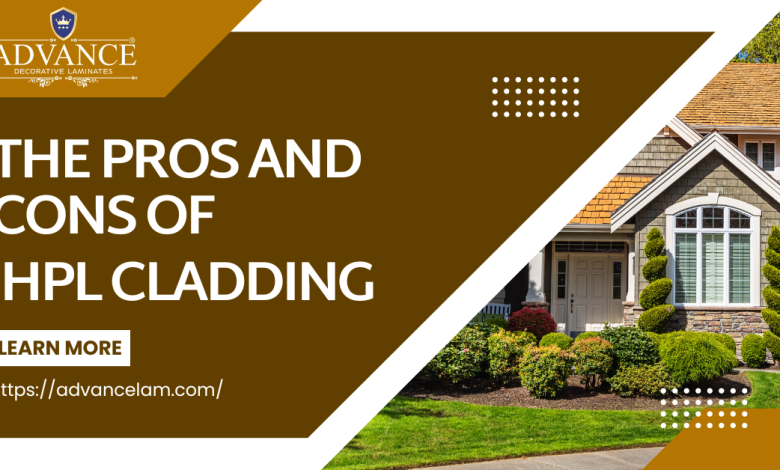Exploring the Pros and Cons of HPL Wall Cladding for Your Building

High-Pressure Laminate (HPL) Wall Cladding is a type of building material made from layers of resin-impregnated paper and/or fabrics that are bonded together under high pressure and temperature. The outer layer is typically a decorative paper or foil that provides the desired texture, colour, and pattern.
It offers several advantages as a building material, including durability, design flexibility, and low maintenance. It is resistant to impact, scratches, stains, UV rays, weather, fire, and chemicals. HPL wall Cladding comes in a wide range of colours and textures, can be customised to fit specific design needs, and can even imitate other materials like wood or metal. Additionally, it is easy to clean and maintain, and resists mould and bacterial growth.
The purpose of this article is to provide readers with a comprehensive understanding of HPL Cladding, its pros and cons, and factors to consider before deciding whether it is the right building material for their project.
Pros of HPL Cladding
Here are some of the pros of HPL Cladding:
Durability and Longevity:
HPL Cladding is an excellent choice for buildings that require long-lasting, durable cladding.
It is resistant to impact, scratches, and stains, making it an ideal material for high traffic areas or areas prone to damage. This characteristic makes it a popular choice for commercial buildings, public spaces, and healthcare facilities.
It has excellent resistance to UV rays and weather. This feature makes it suitable for use in outdoor areas such as building exteriors and balconies. Additionally, HPL wall Cladding is capable of withstanding harsh weather conditions, such as strong winds, heavy rain, and extreme temperatures.
It is also fire-resistant, which makes it an excellent choice for buildings where fire safety is a concern. It can withstand high temperatures and does not release toxic fumes when exposed to flames. HPL Cladding is also resistant to chemicals, making it suitable for use in laboratories and industrial settings.
Design Flexibility and Aesthetics:
HPL Cladding offers a wide range of colour and texture options that can suit any building project’s design needs. HPL wall Cladding is available in a variety of finishes, including matte, glossy, and metallic, providing architects and designers with many possibilities. The colour and texture options can also help buildings stand out and make a statement.
It can be customised to suit the building project’s specific design needs. It can be cut into different shapes and sizes to fit unique spaces, and architects and designers can incorporate patterns and logos into the cladding to create a custom look. This customization possibility makes HPL Cladding an attractive choice for architects and designers who seek unique and personalised designs.
It can imitate other materials, such as wood, stone, or metal. This feature provides a cost-effective way to achieve the desired look of high-end materials without incurring the high cost of using the original materials. HPL Cladding is also lightweight, making it an ideal choice for buildings where heavy materials may not be suitable.
Low Maintenance:
HPL Cladding is easy to clean and maintain. It does not require any special cleaning products, and it can be cleaned with water and soap or a mild detergent. The smooth surface of HPL Cladding also prevents dirt, grime, and other contaminants from sticking to the surface, making it easier to keep clean.
It is also resistant to mould and bacteria growth. The material is non-porous, meaning it does not absorb moisture, which can lead to the growth of mould and bacteria. HPL wall Cladding is also resistant to chemicals, which means it can withstand harsh cleaning products without deteriorating.
Cons of HPL Wall Cladding
High Upfront Cost:
One of the main drawbacks of HPL Cladding is the high upfront cost. HPL Cladding can be more expensive than other cladding materials, such as vinyl or fiber cement. The high cost is due to the material’s quality and durability, which can make it a worthwhile investment in the long run. However, for some building projects with budget constraints, the high upfront cost of HPL wall Cladding may be prohibitive.
In addition to the high upfront cost of HPL Cladding, there are also material and installation expenses to consider. HPL Cladding requires skilled professionals for installation, which can add to the overall cost of the project. Additionally, the material cost of HPL Cladding can vary depending on the colour and texture options chosen, further adding to the overall cost.
Limited Insulation Properties:
HPL Cladding has limited insulation properties when it comes to heat. It is not an effective thermal insulator and can allow heat to escape or enter a building, depending on the climate. This poor insulation can lead to higher energy bills for buildings, especially in extreme climates.
HPL Cladding also has poor insulation properties when it comes to sound. It does not effectively block out noise, and sound can easily travel through the material. This poor insulation against sound can be a concern for buildings located in noisy environments, such as near airports or highways.
Difficulty in Repairing:
HPL Cladding can be difficult to repair, and it requires specialised equipment and expertise to fix any damage or wear over time. The material is strong and durable, but it can be challenging to repair without causing further damage to the surrounding cladding.
Additionally, because HPL Cladding is not as commonly used as other materials, finding a professional with the necessary skills and experience to repair it can be difficult. This can lead to higher repair costs and longer wait times for repairs to be completed.
Considerations before choosing HPL Cladding
Before choosing HPL Cladding for your building, there are several important considerations to keep in mind. In this article, we will explore these considerations to help you make an informed decision.
Building Code Compliance:
Before selecting HPL Cladding for your building, it is essential to ensure that it complies with local building codes and regulations. HPL Cladding must meet fire safety standards, and it is important to verify that the cladding material you choose is compliant with the building code in your area
Project Budget:
HPL Cladding is known for its durability and low maintenance, but it comes at a higher cost than other cladding materials. Before choosing HPL Cladding, it is essential to consider your project budget carefully. You may need to weigh the upfront costs against the long-term benefits of durability and low maintenance.
Design Flexibility and Aesthetics:
HPL Cladding offers a wide range of colour and texture options, and it can be customised to fit your building’s design requirements. Before selecting HPL Cladding, consider your building’s aesthetic needs and whether HPL Cladding will be able to meet them.
Climate and Environment:
HPL Cladding is resistant to weather and UV rays, but it has limited insulation properties. Before selecting HPL Cladding, consider the climate and environment in which your building is located. Buildings in extreme climates may require additional insulation materials to compensate for HPL Cladding’s limited insulation properties.
Maintenance Requirements:
While HPL Cladding is low maintenance, regular cleaning and care are still necessary to keep it in good condition. Consider the maintenance requirements for HPL Cladding before choosing it for your building. Ensure that you have a maintenance plan in place to prevent damage and prolong the life of the cladding.
Repairs and Replacements:
HPL Cladding can be difficult to repair, and it requires specialised equipment and expertise. Before choosing HPL Cladding, consider the potential repair and replacement costs over the lifetime of the building. Ensure that you have a plan in place for any necessary repairs or replacements to avoid unexpected expenses.
Conclusion
HPL cladding is a suitable option for most building types and locations, given its durability, low maintenance, design versatility, and cost-effectiveness. However, building owners should carefully consider specific factors before choosing HPL cladding, such as climate, design, and cost. As with any building material, it is recommended to consult with a qualified professional before making a final decision.
Choose Advance Laminate For Your HPL Cladding service
Looking for HPL cladding services? Advanced Laminates is a manufacturer company that offers high-quality laminates for your cladding needs. Our laminates are made using only the best materials and advanced manufacturing techniques, ensuring that they are durable, long-lasting, and resistant to wear and tear. We offer a wide range of options, including different colors, textures, and finishes, allowing you to customize your HPL cladding to your exact specifications.
Years of industry experience enable us to offer optimal HPL cladding solutions. Choose Advanced Laminates for all your HPL cladding needs and experience the difference for yourself. Don’t hesitate to reach out to us today to learn more about HPL wall cladding and to start your project.





